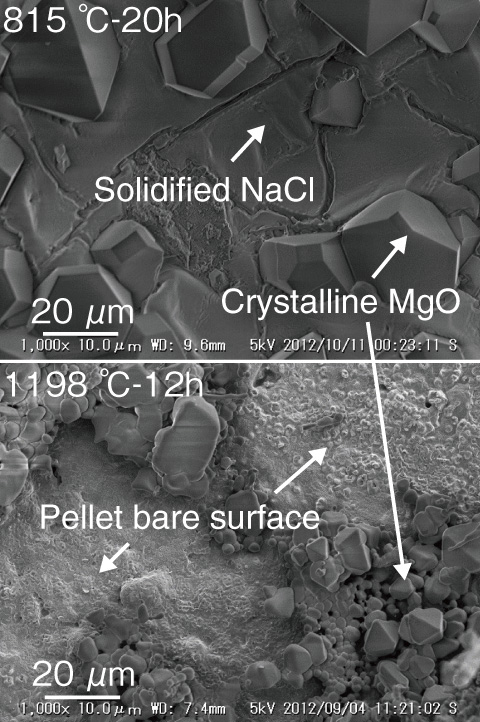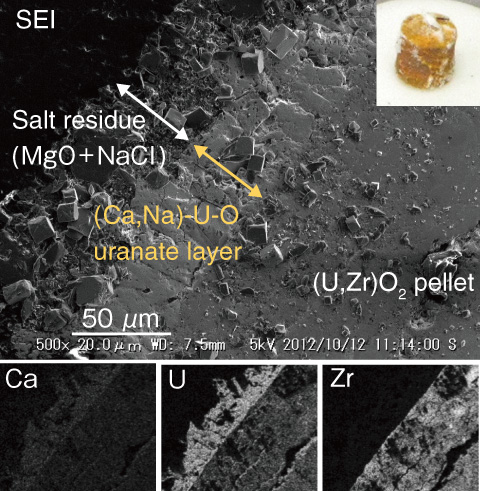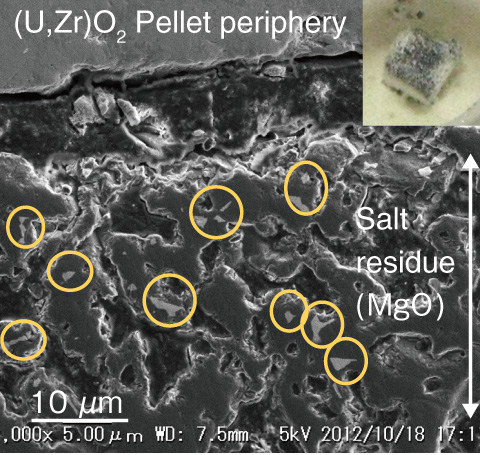
Fig.1-29 SEM images of (U,Zr)O2 pellet surface heat-treated with sea salt

Fig.1-30 SEM and X-ray images of cross section of (U,Zr)O2 pellet heat-treated with sea salt at 1002 °C under airflow

Fig.1-31 SEM image of cross section of (U,Zr)O2 pellet heat-treated with sea salt at 1002 °C under argon gas flow
In the accident at the TEPCO’s Fukushima Daiichi NPS, sea water was injected into the reactor cores for emergency cooling. Sea salt may have been deposited on the high-temperature surface of the core melt at the bottom of the reactor vessels. To investigate the possible impacts of sea water injection on the chemical and physical state of the corium debris, we performed experiments on the high-temperature reactions between sea salt and (U,Zr)O2 simulated corium debris (sim-debris).
First, the decomposition behavior of sea salt at high temperatures was observed. Fig.1-29 shows scanning electron microscopy (SEM) images of the surface of a (U,Zr)O2 pellet heat-treated with sea salt under an argon gas flow. The melting point of NaCl, the main constituent of sea salt, is about 800 °C. After heat treatment at 815 °C, the pellet surface was covered with a solidified NaCl layer, together with crystalline MgO decomposed from magnesium salts. Because NaCl is gradually vaporized at higher temperatures, MgO remains as the main salt residue after heat treatment at 1198 °C.
The reaction products from sea salt and sim-debris were then identified. Fig.1-30 shows the cross section of a (U,Zr)O2 pellet heat-treated with sea salt under an airflow. We have found that a dense layer of calcium and sodium uranate formed on the pellet surface at 1002 °C under an airflow, with a thickness of more than 50 μm. On the other hand, under an argon gas flow, the calcium in sea salt is likely to dissolve into the cubic sim-debris phase to form a solid solution, (Ca,U,Zr)O2+x. The diffusion depth is only 5-6 μm from the surface after treatment at 1198 °C for 12 h. Another interesting finding is a scattering of fine pieces of (Ca,U)O2+x in the MgO residue layer on the pellet surface, as shown in Fig.1-31. In the heating process, calcium uranate forms temporarily because of an oxidizing gas (SOx) evolved from the thermal decomposition of magnesium and calcium sulfates. During isothermal treatment under an argon gas flow, the uranate is reduced to the dioxide solid solution.
From the results of these experiments, we predict that (1) MgO is the main salt residue that may be concomitant with the corium debris to be retrieved, (2) uranate of calcium and sodium may have formed on the debris surface under high oxygen partial pressures, (3) fine pieces of (Ca,U)O2+x may be included in the MgO layer under low oxygen partial pressures.